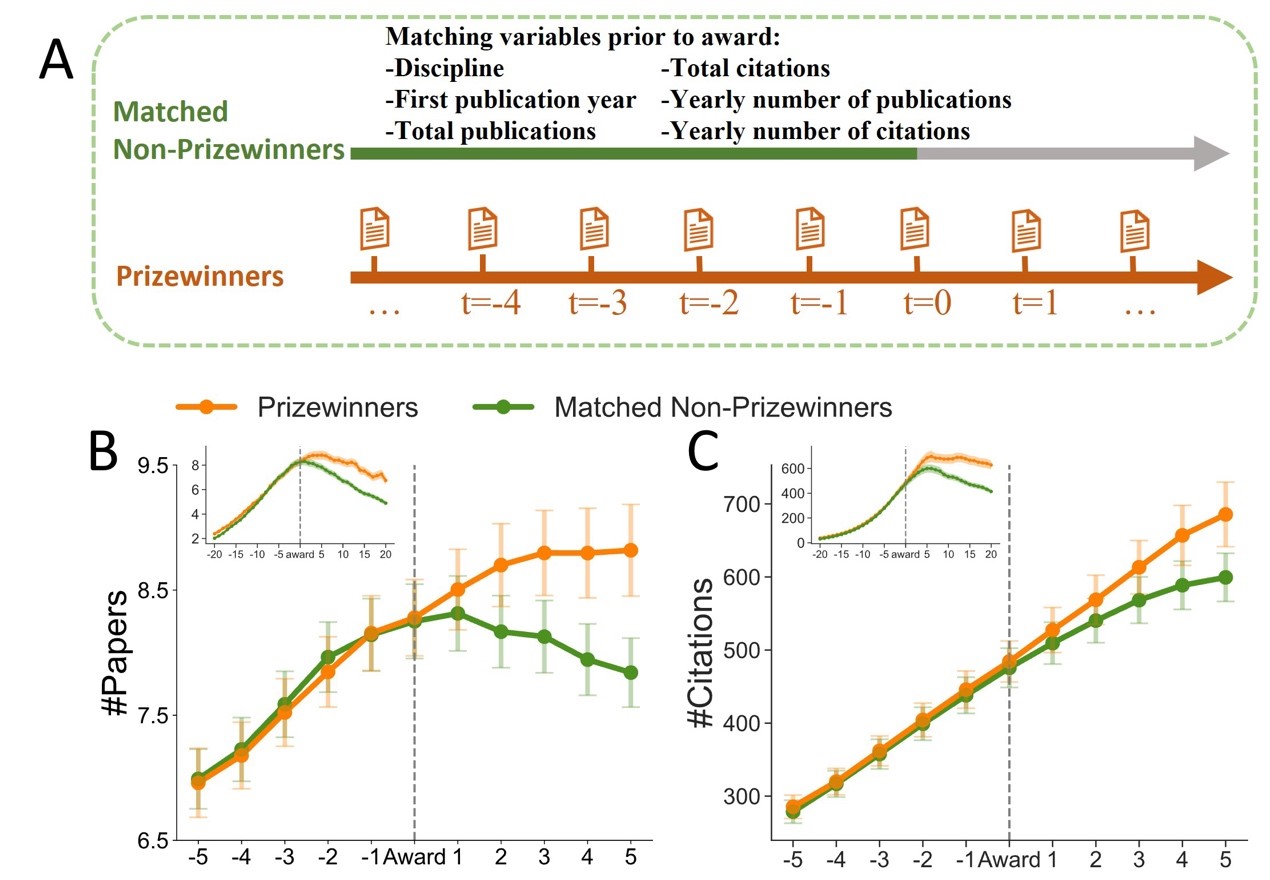Scientific prizes hold exceptional symbolic value in academia and are often regarded as indicators of innovation and research excellence. However, a long-standing debate persists: Are prizewinners truly more innovative than other equally accomplished scientists, or do such prizes merely reflect accumulated prestige? Furthermore, do these awards amplify the “Matthew Effect,” whereby a small group of elites gain increasing recognition and resources while other outstanding researchers are overlooked? These questions have become increasingly relevant as the global system of scientific recognition continues to expand.

Amid Nobel Prize season, the research group led by Assistant Professor Yifang Ma from the Department of Statistics and Data Science at the Southern University of Science and Technology (SUSTech), together with collaborators, has published a study offering quantitative insights into these questions.
Analyzing 2,460 scientific prizes and data on more than 23,000 scientists worldwide, the researchers quantitatively show that prizewinners already demonstrate higher levels of innovation four to five years before receiving an award, and continue to hold that advantage afterward. The study further reveals that a more open and diverse collaboration network—characterized by shorter collaboration durations, lower collaborator overlap, and a broader span of research topics—is closely associated with this sustained innovation advantage.
Their paper has been published in the journal Proceedings of the National Academy of Sciences (PNAS) titled “The distinctive innovation patterns and network embeddedness of scientific prizewinners.”
The team compiled comprehensive data on 2,460 prizes and 7,353 laureates awarded between 1900 and 2018, retrieving corresponding publication records from the OpenAlex database. Using citation networks and co-authorship data, they reconstructed the professional trajectories and collaborative structures of these scientists.
To ensure fair and statistically balanced comparisons, a dynamic optimal matching algorithm was applied to pair each prizewinner with up to five non-laureate scientists of similar discipline, career stage, productivity, and citation impact.

Figure 1. Matching process and validation results for prizewinners and non-winners
The researchers then quantified scientists’ innovativeness using three validated indicators—novelty, convergence, and interdisciplinarity—and analyzed three structural features of their collaboration networks: collaboration duration, partner overlap, and research topic similarity.
The results reveal that scientific prizewinners consistently exhibit a significant and sustained innovation advantage throughout their careers. Their research tends to recombine existing knowledge in new ways, fusing foundational theories from established fields with emerging frontiers, thereby generating groundbreaking outcomes at the intersections of disciplines. This elevated level of creativity is not a temporary phenomenon but a persistent hallmark across their professional lives.
Further analysis shows that this innovation advantage typically emerges years before the award is received. Approximately five years prior to receiving recognition, prizewinners already display markedly higher novelty and interdisciplinarity compared with their non-awarded peers—and these advantages remain robust even after the award. This suggests that scientific prizes primarily recognize long-term innovative performance, rather than merely stimulating it through post-award incentives.

Figure 2. Long-term trends in innovativeness among prizewinners vs. matched non-prizewinners
They also uncovered striking differences in the collaboration network structures of prizewinners. Compared to non-prizewinners, prizewinners tend to build more diverse and open networks—their collaborations are typically shorter in duration, their collaborators overlap less, and their research spans a wider range of topics. This “loose but diverse” collaboration pattern enables continual exposure to new ideas and heterogeneous knowledge, fostering a sustained engine of innovation across disciplinary boundaries.

Figure 3. Dynamic evolution of collaborative network structures among prizewinners vs. matched non-prizewinners
Overall, the findings indicate that the exceptional innovativeness of scientific prizewinners arises not solely from innate talent, but rather the result of flexible collaboration strategies and diverse knowledge networks that nurture creativity over time. Importantly, this work finds no clear evidence that prestigious awards further amplify winners’ established innovation advantages.
This study represents a global-scale quantitative analysis of the innovation patterns and network mechanisms of scientific prizewinners, providing new empirical insights into the social structure of scientific creativity. The results highlight that innovation stems not only from individual genius but also from diverse collaboration and cross-boundary exchange, offering valuable implications for refining research evaluation systems and promoting fairness and effectiveness in scientific award mechanisms.
Ph.D. student Chaolin Tian is the first author, and Assistant Professor Yifang Ma and Professor Brian Uzzi from Northwestern University are co-corresponding authors. SUSTech is the first affiliated institution. Other contributors include Ph.D. student Yurui Huang from Yifang Ma’s group and Assistant Professor Ching Jin from the University of Warwick.
Paper link: https://www.pnas.org/doi/epdf/10.1073/pnas.2424143122
To read all stories about SUSTech science, subscribe to the monthly SUSTech Newsletter.
Proofread ByAdrian Cremin, Yifei REN
Photo ByDepartment of Statistics and Data Science